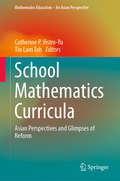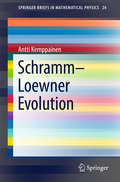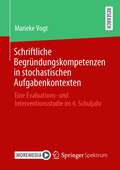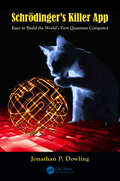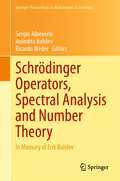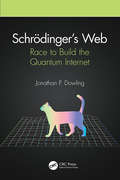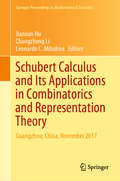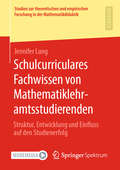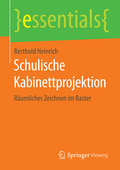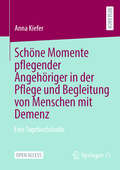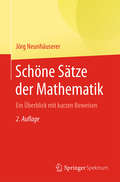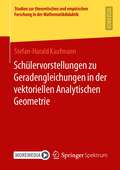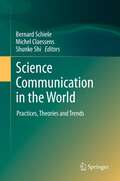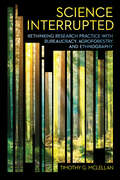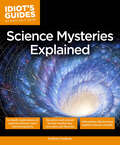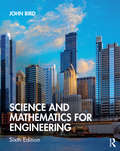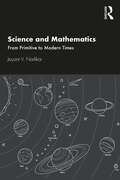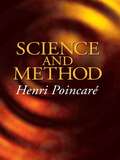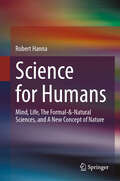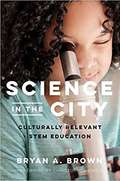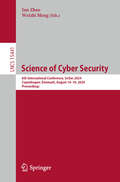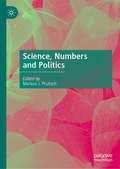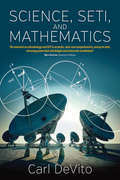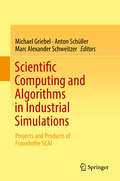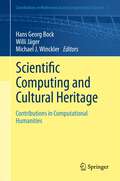- Table View
- List View
School Mathematics Curricula: Asian Perspectives and Glimpses of Reform (Mathematics Education – An Asian Perspective)
by Tin Lam Toh Catherine P. Vistro-YuThis book sheds light on school mathematics curricula in Asian countries, including their design and the recent reforms that have been initiated. By discussing and analyzing various problematic aspects of curriculum development and implementation in a number of East and South Asian countries and offering insights into these countries’ unique approaches to supplementing school mathematics curricula, it contributes to shaping effective policies for implementation, assessment and monitoring of curricula. The book covers a wide range of issues: curriculum design, localization of curricula, directions of curricular reforms, mathematics textbooks, assessment within the curriculum and teachers’ professional development, which are of interest to a wide international audience.
Schramm–Loewner Evolution
by Antti KemppainenThis book is a short, but complete, introduction to the Loewner equation and the SLEs, which are a family of random fractal curves, as well as the relevant background in probability and complex analysis. The connection to statistical physics is also developed in the text in an example case. The book is based on a course (with the same title) lectured by the author. First three chapters are devoted to the background material, but at the same time, give the reader a good understanding on the overview on the subject and on some aspects of conformal invariance. The chapter on the Loewner equation develops in detail the connection of growing hulls and the differential equation satisfied by families of conformal maps. The Schramm-Loewner evolutions are defined and their basic properties are studied in the following chapter, and the regularity properties of random curves as well as scaling limits of discrete random curves are investigated in the final chapter. The book is aimed at graduate students or researchers who want to learn the subject fairly quickly.
Schriftliche Begründungskompetenzen in stochastischen Aufgabenkontexten: Eine Evaluations- und Interventionsstudie im 4. Schuljahr
by Marieke VogtKinder sollen bereits im Mathematikunterricht der Grundschule mathematische Zusammenhänge erklären und begründen. Fraglich ist, wie dieses Thema erfolgreich unterrichtet werden kann. Das vorliegende Buch liefert empirisch überprüfte Ansätze zur Förderung mathematischer Begründungskompetenzen und zeigt auf, wie diese mit dem innermathematischen Themenbereich der Stochastik verknüpft werden können. Die Autorin Marieke Vogt arbeitet derzeit als Grundschullehrerin in Niedersachsen.
Schrodinger's Killer App: Race to Build the World's First Quantum Computer
by Jonathan P. DowlingWritten by a renowned quantum physicist closely involved in the U.S. government's development of quantum information science, this book presents an inside look at the government's quest to build a quantum computer capable of solving complex mathematical problems and hacking the public-key encryption codes used to secure the Internet. The "killer app" refers to Shor's quantum factoring algorithm, which would unveil the encrypted communications of the entire Internet if a quantum computer could be built to run the algorithm. Schrodinger's notion of quantum entanglement-and his infamous cat-is at the heart of it all.
Schrödinger Operators, Spectral Analysis and Number Theory: In Memory of Erik Balslev (Springer Proceedings in Mathematics & Statistics #348)
by Sergio Albeverio Ricardo Weder Anindita BalslevThis book gives its readers a unique opportunity to get acquainted with new aspects of the fruitful interactions between Analysis, Geometry, Quantum Mechanics and Number Theory. The present book contains a number of contributions by specialists in these areas as an homage to the memory of the mathematician Erik Balslev and, at the same time, advancing a fascinating interdisciplinary area still full of potential. Erik Balslev has made original and important contributions to several areas of Mathematics and its applications. He belongs to the founders of complex scaling, one of the most important methods in the mathematical and physical study of eigenvalues and resonances of Schrödinger operators, which has been very essential in advancing the solution of fundamental problems in Quantum Mechanics and related areas. He was also a pioneer in making available and developing spectral methods in the study of important problems in Analytic Number Theory.
Schrödinger’s Web: Race to Build the Quantum Internet
by Jonathan P. DowlingAs the race to build the world&’s first quantum computer is coming to an end, the race to build the quantum internet has just started. This book leverages the author&’s unique insights into both the Chinese and American quantum programs. It begins with the physics and history of the quantum internet and ends with the latest results in quantum computing and quantum networks. The Chinese quantum Sputnik moment. The U.S. National Quantum Initiative. What&’s up with Quantum Computing Supremacy? The Race to Build the Quantum Internet. Where will Quantum Technology be Tomorrow? Written by a renowned quantum physicist, this book is for everyone who is interested in the rapidly advancing field of Quantum Technology — The Second Quantum Revolution. The 2016 launch of the Chinese quantum satellite Mozi was a quantum Sputnik moment. The United States went from thinking it was ten years ahead of the Chinese to the realization that it was ten years behind them. This quantum gap led to the U.S. National Quantum Initiative, launched in 2018. Since then, the race to build the quantum internet has taken off at breakneck speed.
Schubert Calculus and Its Applications in Combinatorics and Representation Theory: Guangzhou, China, November 2017 (Springer Proceedings in Mathematics & Statistics #332)
by Jianxun Hu Changzheng Li Leonardo C. MihalceaThis book gathers research papers and surveys on the latest advances in Schubert Calculus, presented at the International Festival in Schubert Calculus, held in Guangzhou, China on November 6–10, 2017. With roots in enumerative geometry and Hilbert's 15th problem, modern Schubert Calculus studies classical and quantum intersection rings on spaces with symmetries, such as flag manifolds. The presence of symmetries leads to particularly rich structures, and it connects Schubert Calculus to many branches of mathematics, including algebraic geometry, combinatorics, representation theory, and theoretical physics. For instance, the study of the quantum cohomology ring of a Grassmann manifold combines all these areas in an organic way. The book is useful for researchers and graduate students interested in Schubert Calculus, and more generally in the study of flag manifolds in relation to algebraic geometry, combinatorics, representation theory and mathematical physics.
Schulcurriculares Fachwissen von Mathematiklehramtsstudierenden: Struktur, Entwicklung und Einfluss auf den Studienerfolg (Studien zur theoretischen und empirischen Forschung in der Mathematikdidaktik)
by Jennifer LungJennifer Lung entwickelte ein Testinstrument, mithilfe dessen sie das Schulcurriculare Fachwissen von 703 Mathematiklehramtsstudierenden zu unterschiedlichen Zeitpunkten im Studienverlauf erhebt. Diese Trendstudie erlaubt es, die Struktur des Schulcurricularen Fachwissens, dessen Entwicklung im Studienverlauf sowie den Zusammenhang mit dem Studienerfolg zu beschreiben. Die Befunde zeigen, dass sich zwar Teilbereiche des Schulcurricularen Fachwissens im Studienverlauf weiterentwickeln, die Testleistungen jedoch aus Sicht von Hochschullehrenden insgesamt als unzureichend zu bewerten sind. Regressionsanalysen verdeutlichen die Rolle des Schulcurricularen Fachwissens sowohl als Prädiktor als auch als eigenständiger Aspekt von Studienerfolg.
Schulische Kabinettprojektion: Räumliches Zeichnen im Raster (essentials)
by Berthold HeinrichBerthold Heinrich stellt die mathematischen und zeichnerischen Grundlagen für die Darstellung von Objekten im Raum auf kariertem Papier vor. Dabei präsentiert er auch die Nutzung von Software. In der Schule wird oft kariertes Papier als Raster zur Darstellung von Flächen und Körpern genutzt. Allerdings werden, selbst in einigen Druckwerken, z. B. die entstehenden Ellipsen und Winkelbögen ungenau gezeichnet oder eine Kugelkontur falsch als Kreis dargestellt. Im vorliegenden Essential werden die korrekten Verfahren sowohl theoretisch als auch an konkreten Beispielen vorgestellt und können meist direkt umgesetzt werden. Einige aufwändigere Abläufe stellt der Autor anschaulich an Beispielen dar.
Schöne Momente pflegender Angehöriger in der Pflege und Begleitung von Menschen mit Demenz: Eine Tagebuchstudie
by Anna KieferIn diesem Open Access-Buch wird gezeigt, wie pflegende Angehörige mit Hilfe einer Tagebuchvorlage auf die Wahrnehmung schöner Momente in der Begleitung ihrer an Demenz erkrankten Familienmitglieder sensibilisiert werden können. Tagebücher sind eine beliebte Möglichkeit zur Verarbeitung und Bewältigung von Krisensituationen und können dabei der Selbstreflexion und Belastungsverarbeitung dienen. Insbesondere positives Schreiben kann durch das Erinnern und Reflektieren schöner Momente und Emotionen nachweislich zu einem höheren Wohlbefinden und zur Steigerung der Selbstwirksamkeit führen. Die Begleitung eines Menschen mit Demenz geht für pflegende Angehörige häufig mit einer Vielzahl an Belastungen und Herausforderungen einher, weshalb diese häufig aus der Belastungsperspektive erlebt wird. Schöne Momente innerhalb der Sorgebeziehung zwischen pflegenden Angehörigen und Menschen mit Demenz werden dabei seltener bewusst wahrgenommen. Die Ergebnisse der Tagebuchstudie zeigen individuelle Auswirkungen der Wahrnehmung und Sensibilisierung schöner Momente.
Schöne Sätze der Mathematik
by Jörg NeunhäusererIn diesem Buch finden Sie Perlen der Mathematik aus 2500 Jahren, beginnend mit Pythagoras und Euklid über Euler und Gauß bis hin zu Poincaré und Erdös. Sie erhalten einen Überblick über schöne und zentrale mathematische Sätze aus neun unterschiedlichen Gebieten und einen Einblick in große elementare Vermutungen.Die Vielfalt an schönen Resultaten bietet eine einzigartige mathematisch-allgemeinbildende Lektüre auf akademischem Niveau.Die Beweise in diesem Buch sind möglichst einfach und kurz gehalten und vermitteln Ihnen wesentliche Ansätze, Ideen und Strategien ohne große Vorkenntnisse vorauszusetzen. Die verwendeten Begriffe werden zumeist im Text eingeführt und zu grundlegenden Begriffen steht Ihnen zusätzlich ein Anhang zur Verfügung.Als Student der Mathematik oder Naturwissenschaften können Sie das Buch verwenden, um Ihre Perspektive zu erweitern und Ihre mathematische Bildung zu vertiefen. Hochschullehrer können jedes Kapitel des Buches zur Ausgestaltung eines Proseminars heranziehen. Wenn Sie einfach nur an Mathematik interessiert sind, und die Analysis und Lineare Algebra ein wenig kennen, wird Sie dieses Buch in das Reich der reinen Mathematik entführen.Die vorliegende zweite Auflage ist vollständig durchgesehen und um etliche Themen wie zum Beispiel den Satz von Hall und Kettenbrüche ergänzt.
Schülervorstellungen zu Geradengleichungen in der vektoriellen Analytischen Geometrie (Studien zur theoretischen und empirischen Forschung in der Mathematikdidaktik)
by Stefan-Harald KaufmannDie vorliegende qualitative Interviewstudie geht der Frage nach, welche Vorstellungen Schülerinnen und Schüler mit einer Geradengleichung in Vektorform verbinden. Insgesamt 22 Schülerinnen und Schüler der gymnasialen Oberstufe werden mit Hilfe eines leitfadengestützten, problemzentrierten Interviews zu Geradengleichungen in Vektorform aus unterschiedlichen Perspektiven befragt. Die Auswertung der Interviews erfolgt mit einer an die Grounded Theory angelehnten Kategoriengenerierung und einer typenbildenden qualitativen Inhaltsanalyse, die die Bildung von 6 verschiedenen Typen ermöglicht.
Science Communication in the World
by Michel Claessens Shunke Shi Bernard SchieleThis volume is aimed at all those who wonder about the mechanisms and effects of the disclosure of knowledge. Whether they have a professional interest in understanding these processes generally, or they wish to conduct targeted investigations in the PCST field, it will be useful to anyone involved in science communication, including researchers, academics, students, journalists, science museum staff, scientists high public profiles, and information officers in scientific institutions.
Science Interrupted: Rethinking Research Practice with Bureaucracy, Agroforestry, and Ethnography (Expertise: Cultures and Technologies of Knowledge)
by Timothy G. McLellanScience Interrupted examines how scientists in China pursue environmental sustainability within the constraints of domestic and international bureaucracies. Timothy G. McLellan offers a theoretical framework for analyzing the formal procedural work of Chinese bureaucracy—work that is overlooked when China scholars restrict their gaze to the informal and interpersonal channels through which bureaucracy is often navigated. Homing in on an agroforestry research organization in southwest China, the author takes the experiences of the organization's staff in navigating diverse international funding regimes and authoritarian state institutions as entry points for understanding the pervasiveness of bureaucracy in contemporary science. He asks: What if we take the tools, sensibilities, and practices of bureaucracies seriously not only as objects of critique but as resources for re-thinking scientific practice? Extending a mode of anthropological research in which ethnography serves as source of theory as well as source of data, Science Interrupted thinks with, and not only against, bureaucracy. McLellan shows that ethnographic engagement with bureaucracy enables us to imagine more democratic and more collaborative modes of scientific practice.
Science Mysteries Explained: In-Depth Explorations of Natural Science’s Most Fascinating Facts (Idiot's Guides)
by Anthony FordhamIdeal for the armchair science enthusiast, Idiot's Guides: Science Mysteries Explained takes a question/answer-based approach to teach readers a wide variety of topics in Earth Science, Life Science, Chemistry, Physics, and Cosmology. Using helpful full-color illustrations and expert information, this book features 130 fascinating questions and answers to satisfy any scientist wannabe.
Science and Mathematics for Engineering
by John BirdA practical introduction to the engineering science and mathematics required for engineering study and practice.Science and Mathematics for Engineering is an introductory textbook that assumes no prior background in engineering. This new edition covers the fundamental scientific knowledge that all trainee engineers must acquire in order to pass their examinations and has been brought fully in line with the compulsory science and mathematics units in the new engineering course specifications. A new chapter covers present and future ways of generating electricity, an important topic.John Bird focuses upon engineering examples, enabling students to develop a sound understanding of engineering systems in terms of the basic laws and principles. This book includes over 580 worked examples, 1300 further problems, 425 multiple choice questions (with answers), and contains sections covering the mathematics that students will require within their engineering studies, mechanical applications, electrical applications and engineering systems.This book is supported by a companion website of materials that can be found at www.routledge/cw/bird. This resource includes fully worked solutions of all the further problems for students to access, and the full solutions and marking schemes for the revision tests found within the book for instructor use. In addition, all 447 illustrations will be available for downloading by lecturers.
Science and Mathematics: From Primitive to Modern Times
by Jayant V. NarlikarThis book offers an engaging and comprehensive introduction to scientific theories and the evolution of science and mathematics through the centuries. It discusses the history of scientific thought and ideas and the intricate dynamic between new scientific discoveries, scientists, culture and societies. Through stories and historical accounts, the volume illustrates the human engagement and preoccupation with science and the interpretation of natural phenomena. It highlights key scientific breakthroughs from the ancient to later ages, giving us accounts of the work of ancient Greek and Indian mathematicians and astronomers, as well as of the work of modern scientists like Descartes, Newton, Planck, Mendel and many more. The author also discusses the vast advancements which have been made in the exploration of space, matter and genetics and their relevance in the advancement of the scientific tradition. He provides great insights into the process of scientific experimentation and the relationship between science and mathematics. He also shares amusing anecdotes of scientists and their interactions with the world around them. Detailed and accessible, this book will be of great interest to students and researchers of science, mathematics, the philosophy of science, science and technology studies and history. It will also be useful for general readers who are interested in the history of scientific discoveries and ideas.
Science and Method
by Henri PoincaréThis classic by the famous mathematician defines the basic methodology and psychology of scientific discovery, particularly regarding mathematics and mathematical physics. Drawing on examples from many fields, it explains how scientists analyze and choose their working facts, and it explores the nature of experimentation, theory, and the mind. 1914 edition.
Science for Humans: Mind, Life, The Formal-&-Natural Sciences, and A New Concept of Nature
by Robert HannaThis book presents and defends an original and paradigm-shifting conception of formal science, natural science, and the natural universe alike, that’s fully pro-science, but at the same time neither theological or God-centered, nor solipsistic or self-centered, nor communitarian or social-institution-centered, nor scientistic or science-valorizing, nor materialist/physicalist or reductive, nor—above all—mechanistic. It does this by presenting and defending what Robert Hanna calls the neo-organicist turn, including manifest realism and the three sub-parts of metaphysical organicism: liberal naturalism, mind-life continuity, and explanatory inversion, whereby mechanical systems are explained by grounding them in organic systems, and not the other way around. Or more briefly and simply put, the purpose of this book is to present and defend science for humans. As such, it will be highly interesting and profoundly relevant to graduate students and specialist researchers in philosophy and the formal-&-natural sciences.
Science in the City: Culturally Relevant STEM Education (Race And Education Ser.)
by Christopher Emdin Bryan A. BrownScience in the City examines how language and culture matter for effective science teaching. Author Bryan A. Brown argues that, given the realities of our multilingual and multicultural society, teachers must truly understand how issues of culture intersect with the fundamental principles of learning. This book links an exploration of contemporary research on urban science teaching to a more generative instructional approach in which students develop mastery by discussing science in culturally meaningful ways. <P><P> The book starts with a trenchant analysis of the “black tax,” a double standard at work in science language and classrooms that forces students of color to appropriate and express their science knowledge solely in ways that accord with the dominant culture and knowledge regime. Because we are in an interactive, multimedia world, the author also posits the necessity of applying what is known about best practices in science teaching to best practices in technology. <P><P> The book then turns to instruction, illustrating how science education can flourish if it is connected to students’ backgrounds, identities, language, and culture. In this empowered—and inclusive—form of science classroom, the role of narrative is key: educators use stories and anecdotes to induct students into the realm of scientific thinking; introduce big ideas in easy, familiar terms; and prioritize explanation over mastery of symbolic systems. The result is a classroom that showcases how the use of more familiar, culturally relevant modes of communication can pave the way for improved science learning.
Science of Cyber Security: 6th International Conference, SciSec 2024, Copenhagen, Denmark, August 14–16, 2024, Proceedings (Lecture Notes in Computer Science #15441)
by Jun Zhao Weizhi MengThis book constitutes the refereed proceedings of the 6th International Conference on Science of Cyber Security, SciSec 2024, held in Copenhagen, Denmark, during August 14–16, 2024. The 25 full papers presented here were carefully selected and reviewed from 79 submissions. These papers focus on the recent research, trends and challenges in the emerging field of Cyber Security.
Science, Numbers and Politics
by Markus J. PrutschThis study explores the dynamic relationship between science, numbers and politics. What can scientific evidence realistically do in and for politics? The volume contributes to that debate by focusing on the role of “numbers” as a means by which knowledge is expressed and through which that knowledge can be transferred into the political realm. Based on the assumption that numbers are constantly being actively created, translated, and used, and that they need to be interpreted in their respective and particular contexts, it examines how numbers and quantifications are made ‘politically workable’, examining their production, their transition into the sphere of politics and their eventual use therein. Key questions that are addressed include: In what ways does scientific evidence affect political decision-making in the contemporary world? How and why did quantification come to play such an important role within democratic politics? What kind of work do scientific evidence and numbers do politically?
Science, Seti, and Mathematics
by Carl L. DeVitoMathematics is as much a part of our humanity as music and art. And it is our mathematics that might be understandable, even familiar, to a distant race and might provide the basis for mutual communication. This book discusses, in a conversational way, the role of mathematics in the search for extraterrestrial intelligence. The author explores the science behind that search, its history, and the many questions associated with it, including those regarding the nature of language and the philosophical/psychological motivation behind this search.
Scientific Computing and Algorithms in Industrial Simulations
by Michael Griebel Marc Alexander Schweitzer Anton SchüllerThe contributions gathered here provide an overview of current research projects and selected software products of the Fraunhofer Institute for Algorithms and Scientific Computing SCAI. They show the wide range of challenges that scientific computing currently faces, the solutions it offers, and its important role in developing applications for industry. Given the exciting field of applied collaborative research and development it discusses, the book will appeal to scientists, practitioners, and students alike. The Fraunhofer Institute for Algorithms and Scientific Computing SCAI combines excellent research and application-oriented development to provide added value for our partners. SCAI develops numerical techniques, parallel algorithms and specialized software tools to support and optimize industrial simulations. Moreover, it implements custom software solutions for production and logistics, and offers calculations on high-performance computers. Its services and products are based on state-of-the-art methods from applied mathematics and information technology.
Scientific Computing and Cultural Heritage
by Willi Jäger Hans Georg Bock Michael J. WincklerThe sheer computing power of modern information technology is changing the face of research not just in science, technology and mathematics, but in humanities and cultural studies too. Recent decades have seen a major shift both in attitudes and deployment of computers, which are now vital and highly effective tools in disciplines where they were once viewed as elaborate typewriters. This revealing volume details the vast array of computing applications that researchers in the humanities now have recourse to, including the dissemination of scholarly information through virtual 'co-laboratories', data retrieval, and the modeling of complex processes that contribute to our natural and cultural heritage. One key area covered in this book is the versatility of computers in presenting images and graphics, which is transforming the analysis of data sets and archaeological reconstructions alike. The papers published here are grouped into three broad categories that cover mathematical and computational methods, research developments in information systems, and a detailed portrayal of ongoing work on documenting, restoring and presenting cultural monuments including the temples in Pompeii and the Banteay Chhmar temples of the Angkorian period in present-day Cambodia. Originally presented at a research workshop in Heidelberg, Germany, they reflect the rapidly developing identity of computational humanities as an interdisciplinary field in its own right, as well as demonstrating the breadth of perspectives in this young and vibrant research area.
